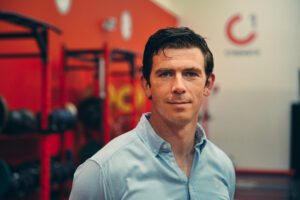In “past, present, future”, we ask clinical or academic experts to reflect on selected Sports & Exercise Medicine topics. Today Enda King on ACL Rehabilitation.

@enda_king
Tell us more about yourself.
I am Head of Performance at the Sports Surgery Clinic in Dublin, married to Michelle and blessed with three kids Ellie (7), Ethan (6) and Iarlaith (3). I completed my undergraduate studies at Trinity College Dublin in 2005, my MSc in Curtin University, Perth in 2010 and my PhD in the University of Roehampton, London in 2019. In my role at SSC, I lead our Elite and Professional Athlete Services, which cater to athletes both nationally and internationally who come for assessment in our 3D biomechanics laboratory or intensive rehabilitation blocks at our campus in Dublin. I am also involved in our research pathways, primarily in Athletic Groin Pain, lower limb biomechanics in injury and performance and ACL rehabilitation, which was the focus of my PhD.
What was hip and happening 10 years ago?
ACL prevention was (and still is) a major focus, with several exercise programs shown to be highly effective in reducing ACL injury incidence, particularly in female athletes. Knee valgus force was still highlighted as the primary ACL injury risk factor. Rehabilitation post ACL reconstruction was (and sometimes still is!) protocol-driven with progression dictated by time from surgery, irrespective of the individual athlete’s baseline physical competency or individual rate of physical recovery post-surgery. Return to play tests were primarily around achieving symmetry of performance across several jump and hop tests.
What are we doing now?
Rehabilitation is more individualized and progressed according to physical competency rather than specific timelines. Physical assessment has progressed to include 3D biomechanical analysis of jump tests and linear running and change of direction mechanics, which highlight rehabilitation deficits not evident through assessment of jump performance symmetry alone. We know that it is impossible to predict future ACL injury from knee valgus (and frontal plane) control alone despite it still being a common movement during the ACL injury mechanism. We know that athletes are twice as likely to suffer a second ACL injury on their non-operated limb. Their plyometric ability and sagittal plane control may be an important factor in influencing future injury.
Where do you think we will be 10 years from now?
There are currently studies looking at various methods of ACL repair (rather than reconstruction) as well as conservative bracing protocols to facilitate spontaneous healing of the ruptured ACL, which may influence the management of ACL injuries and reduce the time required to redevelop physical function post-injury. As databases of surgical and biomechanical data expand, the role of machine learning in classifying future outcomes will become more accurate and powerful. 3D motion analysis will be a staple in every clinical setting, not just for assessing physical function post ACL but across most orthopaedic and MSK injuries. It will progress to markerless motion capture as the technology improves in the years to improve uptake, practicality and ease of use.
Would you like to learn more on this topic? Here is a selection of publications on ACL Injuries in our journal.
- Generalised joint hypermobility increases ACL injury risk and is associated with inferior outcome after ACL reconstruction: a systematic review
- Muscle function is associated with future patient-reported outcomes in young adults with ACL injury
- ACL injury incidence, severity and patterns in professional male soccer players in a Middle Eastern league
- Lower medial hamstring activity after ACL reconstruction during running: a cross-sectional study
- Single-leg balance and core motor control in children: when does the risk for ACL injury occurs?
- ACL reconstruction with hamstring tendon autograft and accelerated brace-free rehabilitation: a systematic review of clinical outcomes
- Physical preparation and return to performance of an elite female football player following ACL reconstruction: a journey to the FIFA Women’s World Cup
- Sex differences in postural orientation errors and association with objective and patient-reported function in patients with ACL injury: an exploratory cross-sectional study